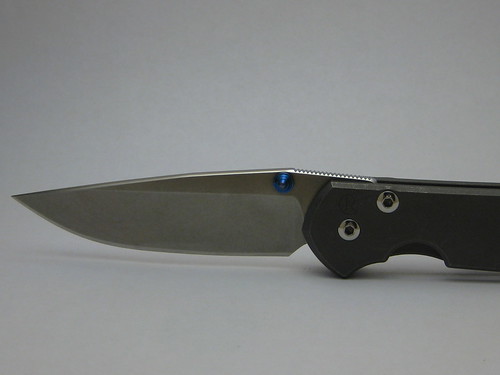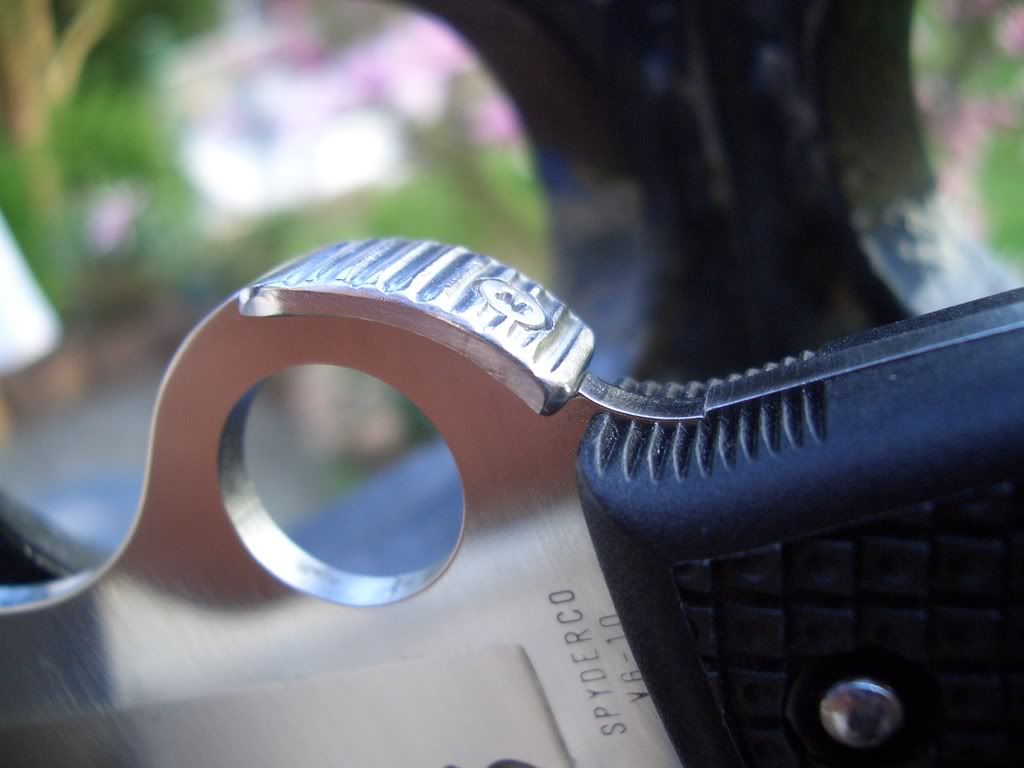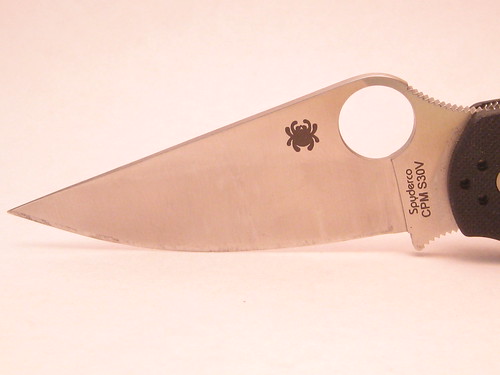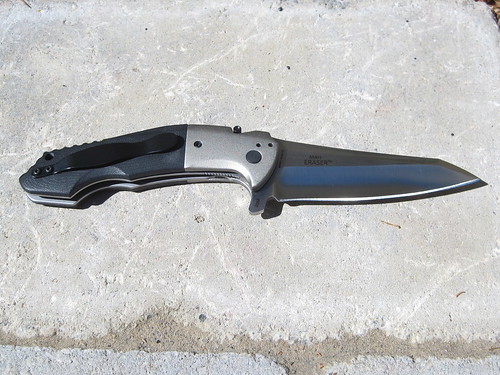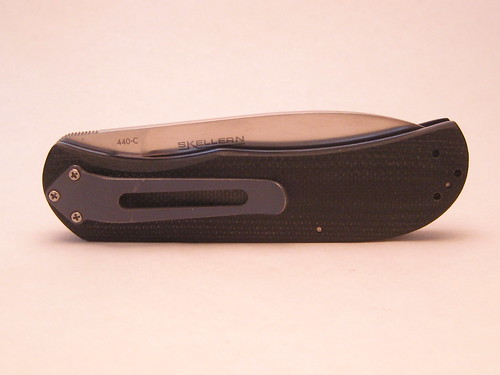EDC Primer: Deployment Methods or Why Banning Switchblades was GOOD for Knife Designs
EDITOR'S NOTE: To kick off the new year I am going to occasionally drop a primer article, introducing terms and ideas to folks new to EDC stuff. So if you made a New Year's resolution to be more prepared or if someone gave you a cool knife or light for Christmas, start here. I am going to try to make them more than basic, here-is-a-list-of-terms-defined articles, so they have broader appeal as well. This first Primer is on Deployment Methods. It is also a brief history of the development of deployment methods since the switchblade ban.
Introduction
Imagine the horror of a person being transported from the late 40s early 50s until today. They'd be stunned at the legalization of marijuana, probably having seen Reefer Madness in a movie theater. Then they'd cringe in horror as "the tool of street gangs", the switchblade, is also being legalized state by state. Its ironic that these two things are linked in today's politics, despite the fact the pro-marijuana and pro-switchblade demographic Venn diagram shows the smallest of overlaps (labeled: libertarian). But this isn't about politics, this is about design.
When the federal Switchblade Knife Act was passed in 1958 (enjoy the specificity of the Act's title, which leaves untouched, fortunately, all of those awesome switchblade combs that were the rage in Showbiz and Chuck E Cheese Pizzas in the 1980s), there were two kinds of folding knives in general use in the US--those with nail knicks and those with switchblades. Gravity knives and balisongs were not really a concern until later. But what happened AFTER switchblades were banned is the really interesting part of the story. In the years since the ban, there have been an abundance of innovations all of which have, at this point, rendered the switchblade all but obsolete. A well made, modern knife can be deployed as fast or faster than a switchblade without running afoul of the law. It is a testament to human innovation and also a cautionary tale to knee-jerk legislators that banned the "demonized object of the minute." They moved on, of course, to other futile and stupid efforts to ban objects that had some immoral taint. Include in this list: guns, books, condoms, clean needles, and a bevvy of other items that seemed to be inventions of the devil, or at least products produced by an wholly owned subsidiary of Satan.
Enough politics though, lets look at the innovations that arose in light of the switchblade ban. The switchblade, especially a double action switchblade, was an amazing upgrade over your grandpa's favorite knife--the nail knick folder. It was stunningly fast (cue fainting Fifties wife), easy to use (cue Greaser sitting on a stack of pallets with a cigarette hanging out of his mouth), and compact. Supposedly the blade deployment alone was enough to deter some attackers. From a design point of view, it was hugely superior to the nail knick folder. It could be used one handed. It was a sure thing. It could be done even when your attention was somewhere else. It was push button convenient. The gap utility-wise between the switchblade and the nail knick folder is akin to the difference between, say, a car and an arthritic horse.
But alas the good ole days never last and dummies in Congress banned the switchblade. Since then folks had to either go back to the old nick knick or devise a new way of opening a knife. Fortunately for all of us, knife makers decided to do both.
When possible I'd like to give credit to the person that invented, popularized, or perfected a given deployment method. Lots of this is lost to the sands of time. More of this attribution is lost to the bullshit of the patent office. Here, for example, is a patent for rotating thumb stud or thumb plate that activates a knife blade. It is, so far as I can tell, identical to similar unpatented inventions in use by CRKT and other custom makers at the time the patent was issued (this, of course, is a reason to deny a patent, but the patent system is fundamentally broken to begin with). Figuring out who invented this things is, absent general consensus or a clear patent, impossible.
Thumb Stud
The first and perhaps most predictable one handed opening method was the thumb stud. Essentially it is a place to wedge your thumb under and push up, opening the blade with one hand. It is my least favorite method of one handed deployment both because it requires a good deal of focus to use (comparatively speaking) and because it is generally an ugly post on a blade breaking up the otherwise clean lines. There are a myriad of different thumb stud designs, some of which are downright painful to use and others of which raise the form to an art form. My favorite thumb studs are those on the Cold Steel Recon series, which are grippy and cleverly ambidextrous, and those found on the Al Mar Ultralight series. The Ultralights have truly awesome thumb studs.
Like a lot of these deployment methods, there is no clear inventor. There is also no clear "first example." Generally, aside from the issues mentioned above, there is the need to make two studs for the knife to be ambidextrous. There is also a problem with the stud snagging on material as the blade is removed from the pocket. It is a question of fine balance. Too much width and the stud snags on everything. Not enough and it is hard to reach. Finding that balance is very challenging especially for mass production companies where one stud is fitted to blades of varying thicknesses.
Thumb Notch
Somewhere between a thumb plate and a nail knick is a thumb notch. Seen on knives like the AG Russell Sunfish and the Chris Reeve Mnandi, the thumb notch is a classy looking deployment method, but I am not sure how reliable it is. There is not much of an edge to grip on to, though my experience with them is fleeting, handling a few blades at knife shows and the like. The benefits are pretty clear--it doesn't screw up the lines on a knife keeping the blade aesthetics mostly intact, it doesn't add any snag points on the knife, and it is very low profile.
One take on this that looks really awesome is by a Massachusetts custom maker Chuck Gedraitis. Gedraitis's innovation, called a Shark Bite opener, is to use a more aggressive edge on the thumb notch to really dig into a thumb. He claims it works even with gloves, which is especially awesome.
Thumb Plate
The thumb plate operates in very much the same manner that the thumb stud does, providing a place to stop the thumb and place pressure on the knife forcing it to deploy. The thumb stud is a more elegant solution, marring the aesthetics of the blade to much lesser degree and curing the "thickness" issues mentioned above. They are, in my opinion, much easier to use than a thumb stud as well. I still think they are unnecessarily difficult to use (again relatively speaking) because you have to focus on keeping your thumb on the disk itself in order to successfully deploy the blade.
The knife above, the Emerson A-100, is one of the more widely recognized knives to use a thumb disk. Additionally, there are plate variants that have a square piece of steel instead of a disk. the Cold Steel AK-47 has a thumb plate. John W. Smith is a well-know custom maker with a proclivity for thumb plates. His designs are quite elegant. There is also a variant that fixes the main problem unique to the thumb plates--plate rotation. With only one anchor point, the plate can spin in place making deployment difficult. One solution is to flatten two of the edges making it impossible for the plate to rotate. Finally, Sal Glesser and Spyderco introduced an even more advanced version of the plate called the Cobra Hood, seen here:
It has been mostly discontinued, though it can be found on the Spyderco Assist, a rescue knife.
Thumb Hole
Finally, a opening method I really like. In my mind the thumb hole and its different shaped variants, is the superior one handed deployment method. It takes less focus, as your thumb pad is surrounded by the material, instead of merely in contact with it in one place. It also can be "rolled" open slowly or flicked open. Finally, and I know this has some vocal dissenters, but I think it looks attractive. The hole usually allows for some kind of thumb ramp, increasing its utility. You can also use the hole as a pinch point to deploy the knife using something informally known as a "Spydie Drop" seen here in this video:
The thumb hole was popularized, if not invented, by Sal Glesser and Spyderco. The knife shown above, the Paramilitary 2, has a particularly refined thumb hole that is perfectly sized for fast deployment. Brad Southard, a custom knife maker, has textured the interior of the hole on his Downing, one of my grail knives. He does this to make it even easier for the thumb to stay in the hole. One especially BAD version of the thumb hole can be found on the Benchmade Skirmish line. There the hole's edge is chamfered making it very easy for the thumb to slip out of the hole.
There are a number of variants, including a comet shaped hole used on Spyderco's Byrd line of knives and an oval used in many places. Tom Mayo, a custom maker, is particularly well known for his thumb hole oval opener, seen here on one of the most amazing knives I have ever had a chance to handle, the Mayo Covert:
Wave
Of all the deployment methods, this one has the clearest history, indisputably orginating from the mind of Ernie Emerson, the owner of Emerson knives. Here is a quick video showing you how it works:
According to Ernie it was original devised as a quillion for a combat folder. He noticed while fidgeting with the folder that he could deploy it as he pulled it out of his pocket. This made for an stunningly fast deployment, faster than, as the video points out, even a switchblade. I have used a waved knife before and I like it a lot though I have no real need for the speed.
There are a few variants. First there are the licensed versions on the Endura and Delica folders from Spyderco. They work at least as well as the originals. A few combat knives, like the P'Kal from Spyderco have projections that work like the wave hook. The aforementioned Cold Steel AK-47's thumb plates also work like wave hooks, allowing you to deploy the knife very quickly.
Flipper
The new rage in knives, and one again, with a clear origin. Most attribute the invention of the flipper to custom maker extraordinaire Kit Carson. Here is one of the most widely sold flippers in existence:
The small protrusion under the pivot of the blade pokes through the spine of the knife when closed. pressing or pulling on it causes the knife to overcome the pressure of the detent (a small knob or ball bearing that sits in a dent on the blade itself, that when in that dent holds the knife closed with a slight amount of pressure) and "fire" open. Flippers have to have smooth pivots (via good washers or bearing pivots) or assists. They require a lot of fine tuning and when made cheaply, are very difficult to use. However, in the hands of a master, a flipper is like no other deployment method. It is fun to use and quite fast. This is my second favorite deployment method and it is not that far behind the thumb hole.
GTC makes some pretty amazing flippers. The grail knife for many folks, the XM-18, is a flipper. Additionally some of the nicest production blades, like the Kershaw Tilt, the Spyderco Southard, and the ZT56X series are all flippers. One of my favorite very large folders, the Eraser, is a sublimely smooth flipper:
Flippers, because of their need for the detent, usually come in frame lock or liner lock knives only, though Benchmade recently released an Axis lock flipper.
There are also flippers that have parallel flippers instead of those that are perpendicular to the blade:
I like both variants, and the ease of use depends on the quality of execution. Moreso than with any other deployment method, the finer the knife the better the flipper. An expensive thumb stud is still just as crappy, it just might have a sapphire in it.
Assist
My least favorite one handed opening method is the thumb stud, but the Assist is not far behind. It is, in essence, half a switchblade. Part of what makes a switchblade a switchblade is the switch, or button. An assist has the spring or torqued piece of steel that a switchblade does, but uses other methods to open. It is really not its own deployment method, as there needs to be a flipper or a hole or a stud to help out, but it is something people look for. My big issue with the assist is that it is unnecessary. If a switchblade is not necessary, then clearly half a switchblade is even less useful. For situations that REQUIRE fast and sure deployment, such as EMTs or combat troops, maybe an assist is helpful, but even then it is just another part to break or fail.
Other Methods
There are a bevvy of other ideas for deploying a blade, but they are too numerous and different to lump together. Some like this Camillus, use a path in the blade tang and a button to swing open through the pivot quickly. Others like this Burger design, use jimping and a well-made pivot to open quickly:
I hated the Boker version of this knife, but the custom or mid-tech versions are both very effective and nice.
Conclusion
The ban on switchblades and other knives was a huge boon design-wise for knife makers. The forced change spawned a number of creative designs, some of which are simply superior in every way to a switchblade knife (the wave for example, does everything a switchblade does and does it faster). I like the thumb hole and the flipper the best and the stud and the assist the least, but good versions of any deployment method are more than adequate. The epilogue to this whole legislative mess is a good one. Many states have repealed the ban on switchblades and other knives, recognizing both the absurdity of the original ban and the fact that other knives have simply surpassed the switchblade's feared speed. This means that quite a few of us can buy switchblades again and enjoy their clean lines and fast deployment. Though not necessary anymore, they are quite a wonderful luxury item.
Introduction
Imagine the horror of a person being transported from the late 40s early 50s until today. They'd be stunned at the legalization of marijuana, probably having seen Reefer Madness in a movie theater. Then they'd cringe in horror as "the tool of street gangs", the switchblade, is also being legalized state by state. Its ironic that these two things are linked in today's politics, despite the fact the pro-marijuana and pro-switchblade demographic Venn diagram shows the smallest of overlaps (labeled: libertarian). But this isn't about politics, this is about design.
When the federal Switchblade Knife Act was passed in 1958 (enjoy the specificity of the Act's title, which leaves untouched, fortunately, all of those awesome switchblade combs that were the rage in Showbiz and Chuck E Cheese Pizzas in the 1980s), there were two kinds of folding knives in general use in the US--those with nail knicks and those with switchblades. Gravity knives and balisongs were not really a concern until later. But what happened AFTER switchblades were banned is the really interesting part of the story. In the years since the ban, there have been an abundance of innovations all of which have, at this point, rendered the switchblade all but obsolete. A well made, modern knife can be deployed as fast or faster than a switchblade without running afoul of the law. It is a testament to human innovation and also a cautionary tale to knee-jerk legislators that banned the "demonized object of the minute." They moved on, of course, to other futile and stupid efforts to ban objects that had some immoral taint. Include in this list: guns, books, condoms, clean needles, and a bevvy of other items that seemed to be inventions of the devil, or at least products produced by an wholly owned subsidiary of Satan.
Enough politics though, lets look at the innovations that arose in light of the switchblade ban. The switchblade, especially a double action switchblade, was an amazing upgrade over your grandpa's favorite knife--the nail knick folder. It was stunningly fast (cue fainting Fifties wife), easy to use (cue Greaser sitting on a stack of pallets with a cigarette hanging out of his mouth), and compact. Supposedly the blade deployment alone was enough to deter some attackers. From a design point of view, it was hugely superior to the nail knick folder. It could be used one handed. It was a sure thing. It could be done even when your attention was somewhere else. It was push button convenient. The gap utility-wise between the switchblade and the nail knick folder is akin to the difference between, say, a car and an arthritic horse.
But alas the good ole days never last and dummies in Congress banned the switchblade. Since then folks had to either go back to the old nick knick or devise a new way of opening a knife. Fortunately for all of us, knife makers decided to do both.
When possible I'd like to give credit to the person that invented, popularized, or perfected a given deployment method. Lots of this is lost to the sands of time. More of this attribution is lost to the bullshit of the patent office. Here, for example, is a patent for rotating thumb stud or thumb plate that activates a knife blade. It is, so far as I can tell, identical to similar unpatented inventions in use by CRKT and other custom makers at the time the patent was issued (this, of course, is a reason to deny a patent, but the patent system is fundamentally broken to begin with). Figuring out who invented this things is, absent general consensus or a clear patent, impossible.
Thumb Stud
The first and perhaps most predictable one handed opening method was the thumb stud. Essentially it is a place to wedge your thumb under and push up, opening the blade with one hand. It is my least favorite method of one handed deployment both because it requires a good deal of focus to use (comparatively speaking) and because it is generally an ugly post on a blade breaking up the otherwise clean lines. There are a myriad of different thumb stud designs, some of which are downright painful to use and others of which raise the form to an art form. My favorite thumb studs are those on the Cold Steel Recon series, which are grippy and cleverly ambidextrous, and those found on the Al Mar Ultralight series. The Ultralights have truly awesome thumb studs.
Like a lot of these deployment methods, there is no clear inventor. There is also no clear "first example." Generally, aside from the issues mentioned above, there is the need to make two studs for the knife to be ambidextrous. There is also a problem with the stud snagging on material as the blade is removed from the pocket. It is a question of fine balance. Too much width and the stud snags on everything. Not enough and it is hard to reach. Finding that balance is very challenging especially for mass production companies where one stud is fitted to blades of varying thicknesses.
Thumb Notch
Somewhere between a thumb plate and a nail knick is a thumb notch. Seen on knives like the AG Russell Sunfish and the Chris Reeve Mnandi, the thumb notch is a classy looking deployment method, but I am not sure how reliable it is. There is not much of an edge to grip on to, though my experience with them is fleeting, handling a few blades at knife shows and the like. The benefits are pretty clear--it doesn't screw up the lines on a knife keeping the blade aesthetics mostly intact, it doesn't add any snag points on the knife, and it is very low profile.
One take on this that looks really awesome is by a Massachusetts custom maker Chuck Gedraitis. Gedraitis's innovation, called a Shark Bite opener, is to use a more aggressive edge on the thumb notch to really dig into a thumb. He claims it works even with gloves, which is especially awesome.
Thumb Plate
The thumb plate operates in very much the same manner that the thumb stud does, providing a place to stop the thumb and place pressure on the knife forcing it to deploy. The thumb stud is a more elegant solution, marring the aesthetics of the blade to much lesser degree and curing the "thickness" issues mentioned above. They are, in my opinion, much easier to use than a thumb stud as well. I still think they are unnecessarily difficult to use (again relatively speaking) because you have to focus on keeping your thumb on the disk itself in order to successfully deploy the blade.
The knife above, the Emerson A-100, is one of the more widely recognized knives to use a thumb disk. Additionally, there are plate variants that have a square piece of steel instead of a disk. the Cold Steel AK-47 has a thumb plate. John W. Smith is a well-know custom maker with a proclivity for thumb plates. His designs are quite elegant. There is also a variant that fixes the main problem unique to the thumb plates--plate rotation. With only one anchor point, the plate can spin in place making deployment difficult. One solution is to flatten two of the edges making it impossible for the plate to rotate. Finally, Sal Glesser and Spyderco introduced an even more advanced version of the plate called the Cobra Hood, seen here:
It has been mostly discontinued, though it can be found on the Spyderco Assist, a rescue knife.
Thumb Hole
Finally, a opening method I really like. In my mind the thumb hole and its different shaped variants, is the superior one handed deployment method. It takes less focus, as your thumb pad is surrounded by the material, instead of merely in contact with it in one place. It also can be "rolled" open slowly or flicked open. Finally, and I know this has some vocal dissenters, but I think it looks attractive. The hole usually allows for some kind of thumb ramp, increasing its utility. You can also use the hole as a pinch point to deploy the knife using something informally known as a "Spydie Drop" seen here in this video:
The thumb hole was popularized, if not invented, by Sal Glesser and Spyderco. The knife shown above, the Paramilitary 2, has a particularly refined thumb hole that is perfectly sized for fast deployment. Brad Southard, a custom knife maker, has textured the interior of the hole on his Downing, one of my grail knives. He does this to make it even easier for the thumb to stay in the hole. One especially BAD version of the thumb hole can be found on the Benchmade Skirmish line. There the hole's edge is chamfered making it very easy for the thumb to slip out of the hole.
There are a number of variants, including a comet shaped hole used on Spyderco's Byrd line of knives and an oval used in many places. Tom Mayo, a custom maker, is particularly well known for his thumb hole oval opener, seen here on one of the most amazing knives I have ever had a chance to handle, the Mayo Covert:
Wave
Of all the deployment methods, this one has the clearest history, indisputably orginating from the mind of Ernie Emerson, the owner of Emerson knives. Here is a quick video showing you how it works:
According to Ernie it was original devised as a quillion for a combat folder. He noticed while fidgeting with the folder that he could deploy it as he pulled it out of his pocket. This made for an stunningly fast deployment, faster than, as the video points out, even a switchblade. I have used a waved knife before and I like it a lot though I have no real need for the speed.
There are a few variants. First there are the licensed versions on the Endura and Delica folders from Spyderco. They work at least as well as the originals. A few combat knives, like the P'Kal from Spyderco have projections that work like the wave hook. The aforementioned Cold Steel AK-47's thumb plates also work like wave hooks, allowing you to deploy the knife very quickly.
Flipper
The new rage in knives, and one again, with a clear origin. Most attribute the invention of the flipper to custom maker extraordinaire Kit Carson. Here is one of the most widely sold flippers in existence:
The small protrusion under the pivot of the blade pokes through the spine of the knife when closed. pressing or pulling on it causes the knife to overcome the pressure of the detent (a small knob or ball bearing that sits in a dent on the blade itself, that when in that dent holds the knife closed with a slight amount of pressure) and "fire" open. Flippers have to have smooth pivots (via good washers or bearing pivots) or assists. They require a lot of fine tuning and when made cheaply, are very difficult to use. However, in the hands of a master, a flipper is like no other deployment method. It is fun to use and quite fast. This is my second favorite deployment method and it is not that far behind the thumb hole.
GTC makes some pretty amazing flippers. The grail knife for many folks, the XM-18, is a flipper. Additionally some of the nicest production blades, like the Kershaw Tilt, the Spyderco Southard, and the ZT56X series are all flippers. One of my favorite very large folders, the Eraser, is a sublimely smooth flipper:
Flippers, because of their need for the detent, usually come in frame lock or liner lock knives only, though Benchmade recently released an Axis lock flipper.
There are also flippers that have parallel flippers instead of those that are perpendicular to the blade:
I like both variants, and the ease of use depends on the quality of execution. Moreso than with any other deployment method, the finer the knife the better the flipper. An expensive thumb stud is still just as crappy, it just might have a sapphire in it.
Assist
My least favorite one handed opening method is the thumb stud, but the Assist is not far behind. It is, in essence, half a switchblade. Part of what makes a switchblade a switchblade is the switch, or button. An assist has the spring or torqued piece of steel that a switchblade does, but uses other methods to open. It is really not its own deployment method, as there needs to be a flipper or a hole or a stud to help out, but it is something people look for. My big issue with the assist is that it is unnecessary. If a switchblade is not necessary, then clearly half a switchblade is even less useful. For situations that REQUIRE fast and sure deployment, such as EMTs or combat troops, maybe an assist is helpful, but even then it is just another part to break or fail.
Other Methods
There are a bevvy of other ideas for deploying a blade, but they are too numerous and different to lump together. Some like this Camillus, use a path in the blade tang and a button to swing open through the pivot quickly. Others like this Burger design, use jimping and a well-made pivot to open quickly:
I hated the Boker version of this knife, but the custom or mid-tech versions are both very effective and nice.
Conclusion
The ban on switchblades and other knives was a huge boon design-wise for knife makers. The forced change spawned a number of creative designs, some of which are simply superior in every way to a switchblade knife (the wave for example, does everything a switchblade does and does it faster). I like the thumb hole and the flipper the best and the stud and the assist the least, but good versions of any deployment method are more than adequate. The epilogue to this whole legislative mess is a good one. Many states have repealed the ban on switchblades and other knives, recognizing both the absurdity of the original ban and the fact that other knives have simply surpassed the switchblade's feared speed. This means that quite a few of us can buy switchblades again and enjoy their clean lines and fast deployment. Though not necessary anymore, they are quite a wonderful luxury item.

